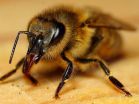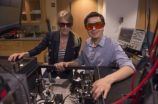(Press-News.org) Promoting a healthy diet from infancy is important to prevent childhood obesity and the onset of chronic disease.
This is the finding from a study published in the latest issue of Australian and New Zealand Journal of Public Health.
Led by Rebecca Byrne from QUT, the study described quantity and diversity of food and drinks consumed by children aged 12-16 months.
"The toddler years are a critical age in the development of long-term food preferences, but this is also the age that autonomy, independence and food fussiness begins," Ms Byrne said.
"Childhood obesity in Australia has doubled since 1986, with about 21% of children aged 2-3 years now classified as overweight or obese.
"Liking a nutrient-dense diet that incorporates all five food groups is important, as evidence suggests that food preferences develop at this early age and persist into adulthood.
"Iron deficiency also remains an issue for toddlers in both developed and developing countries.
"Although most toddlers were consuming a diverse diet, the amount and type of meat or meat alternatives was poor. Almost all children were consuming foods we would consider completely unnecessary at this age, such as sweet biscuits."
INFORMATION: END
Healthy diet set early in life
2014-08-06
ELSE PRESS RELEASES FROM THIS DATE:
Nutrition an issue for Indigenous Australians
2014-08-06
Nutrition has not been given enough priority in national Aboriginal and Torres Strait Islander health policy in recent years.
This is the finding from a study published in the latest issue of Australian and New Zealand Journal of Public Health.
Led by Jennifer Browne from La Trobe University, the study examined Aboriginal-specific health policies and strategies developed between 2000 and 2012.
"Increased inclusion of nutrition in Aboriginal health policy was identified during the first half of this period, but less during the second where a much greater emphasis was ...
Crime Victims' Institute tracks the state of stalking in Texas
2014-08-06
HUNTVILLE (8/6/14) -- According to a 2010 survey by the Center for Disease Control and Prevention (CDC), an estimated 1.4 million women in Texas experience stalking during their lifetimes. Despite recent laws adopted in the state to protect stalking victims, little information is available about the crime or policies and procedures to aid the criminal justice system, according to a report from the Crime Victims' Institute (CVI).
According to CDC estimates, 15.6 percent of the female population in Texas will experience stalking, slightly less than the 16.2 percent national ...
Vanderbilt finding may aid recovery from spinal cord injury
2014-08-05
Researchers in the Vanderbilt University Institute of Imaging Science (VUIIS) have achieved the first conclusive non-invasive measurement of neural signaling in the spinal cords of healthy human volunteers.
Their technique, described today in the journal eLife, may aid efforts to help patients recover from spinal cord injuries and other disorders affecting spinal cord function, including multiple sclerosis.
"We definitely hope that this work can be translated to address many neurological disorders," said the paper's first author, Robert Barry, Ph.D., a postdoctoral ...
Researchers boost insect aggression by altering brain metabolism
2014-08-05
CHAMPAIGN, Ill. — Scientists report they can crank up insect aggression simply by interfering with a basic metabolic pathway in the insect brain. Their study, of fruit flies and honey bees, shows a direct, causal link between brain metabolism (how the brain generates the energy it needs to function) and aggression.
The team reports its findings in the Proceedings of the National Academy of Sciences.
The new research follows up on previous work from the laboratory of University of Illinois entomology professor and Institute for Genomic Biology director Gene Robinson, ...
This week from AGU: Sea-level spikes, volcanic risk, volcanos cause drought
2014-08-05
From AGU's blogs: Sea-level spikes can harm beaches worse than hurricane
Unforeseen, short-term increases in sea level caused by strong winds, pressure changes and fluctuating ocean currents can cause more damage to beaches on the East Coast over the course of a year than a powerful hurricane making landfall, according to a new study. The new research suggests that these sea-level anomalies could be more of a threat to coastal homes and businesses than previously thought, and could become higher and more frequent as a result of climate change, according to a new study ...
Biology made simpler with clear tissues
2014-08-05
In general, our knowledge of biology—and much of science in general—is limited by our ability to actually see things. Researchers who study developmental problems and disease, in particular, are often limited by their inability to look inside an organism to figure out exactly what went wrong and when.
Now, thanks to techniques developed at Caltech, scientists can see through tissues, organs, and even an entire body. The techniques offer new insight into the cell-by-cell makeup of organisms—and the promise of novel diagnostic medical applications.
"Large volumes of tissue ...
Researchers uncover novel process for creation of fuel and chemical compounds
2014-08-05
MADISON, Wis. — A team of researchers at the University of Wisconsin-Madison has identified the genes and enzymes that create a promising compound — the 19 carbon furan-containing fatty acid (19Fu-FA). The compound has a variety of potential uses as a biological alternative for compounds currently derived from fossil fuels.
Researchers from the Great Lakes Bioenergy Research Center (GLBRC), which is headquartered at UW-Madison and funded by the U.S. Department of Energy, discovered the cellular genomes that direct 19Fu-FA's synthesis and published the new findings Aug. ...
Baby aspirin? Many doctors don't recommend, despite guidelines
2014-08-05
A majority of middle-aged men and women eligible to take aspirin to prevent heart attack and stroke do not recall their doctors ever telling them to do so, according to a University of Rochester study of a national sample of more than 3,000 patients.
Published online by the Journal of General Internal Medicine, the finding illustrates a common disconnect between public health guidelines and what occurs in clinical practice. The UR study is consistent with other research showing that physicians often do not recommend aspirin as prevention therapy to the general population, ...
Pistachios may lower vascular response to stress in type 2 diabetes
2014-08-05
Among people with type 2 diabetes, eating pistachios may reduce the body's response to the stresses of everyday life, according to Penn State researchers.
"In adults with diabetes, two servings of pistachios per day lowered vascular constriction during stress and improved neural control of the heart," said Sheila G. West, professor of biobehavioral health and nutritional sciences. "Although nuts are high in fat, they contain good fats, fiber, potassium and antioxidants. Given the high risk of heart disease in people with diabetes, nuts are an important component of a ...
Watching chemistry in motion: Chemical environments mapped using molecular vibrations
2014-08-05
Scientists have long known that a molecule's behavior depends on its environment. Taking advantage of this phenomenon, a group of researchers at the University of Chicago developed a new technique to map microscopic environments using the vibrations of molecules.
"It's a special new advance that will be broadly useful in studies of molecular and materials phenomena," said Andrei Tokmakoff, the Henry G. Gale Distinguished Service Professor in Chemistry at UChicago. He and two of his associates report their new technique in a paper published online in the journal Optics ...



